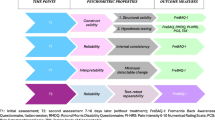Abstract
This study was conducted to determine the validity and reliability of the Body Awareness Questionnaire (BAQ) in patients with non-specific chronic low back pain. A total of 180 participants (96 women, 84 men), aged 21–64 years, with non-specific chronic low back pain were enrolled from June to December 2019. Sociodemographic features were collected. The pain intensity using the Visual Analog Scale, the disability status due to low back pain with the Oswestry Disability Index (ODI), the body awareness level using the BAQ, and self-esteem using the Rosenberg Self-Esteem Scale (RSES) were assessed. Test–retest reliability was assessed by intraclass correlation coefficients in patients 7 days apart. The mean age of the study subjects was 42.14 ± 13.27 years. The scale was found to be reliable in patients experiencing non-specific chronic low back pain. The Cronbach’s alpha reliability coefficient was 0.767. The internal consistency ranged from 0.718 to 1.00 in the items. Intraclass correlation coefficients of items ranged from 0.560 to 1.000. Intraclass correlation coefficient of BAQ total score was found to be 0.786 (p = 0.000) in test–retest results. The scores of RSES were compared in order to assess the concurrent validity of BAQ. The concurrent validity analyses showed that the BAQ and RSES were significantly correlated (r = 0.188; p = 0.012). The BAQ is a valid and reliable scale for determining body awareness status in patients with non-specific chronic low back pain.
Similar content being viewed by others
References
Van Hecke O, Torrance N, Smith BH (2013) Chronic pain epidemiology and its clinical relevance. Br J Anaesth 111(1):13–18. https://doi.org/10.1093/bja/aet123
Gatchel RJ, Peng YB, Peters ML et al (2007) The biopsycosocial approach to chronic pain: scientific advances and future directions. Psychol Bull 133(4):581–624
Pimlott-Kubiak S, Cortina LM (2003) Gender, victimization, and outcomes: Reconceptualizing risk. J Consult Clin Psychol 71(3):528–539. https://doi.org/10.1037/0022-006X.71.3.528
Roxendal G (1985) Body-awareness therapy and the Body Awareness Scale treatment and evaluation. Dissertation, University of Gothenburg
Dahlberg K, Dahlberg H, Nystrom M (2008) Reflective lifeworld research: student litteratur. Indo Pac J Phenomenol 9(1):1–4
Dennenberg N, Reeves GD (1995) Changes in health locus of control and activities of daily living in a physical therapy clinic using the Feldenkrais method of sensory motor education. Dissertation, Oakland University
Phipps A, Lopez R, Powell R (1997) A functional outcome study on the use of movement re-education in chronic pain management. Dissertation, Pacific University
Hansell S, Mechanic D (1991) Body awareness and self-assessed health among older adults. J Aging Health 3(4):473–492
Karaca S (2017) Turkish version of Body Awareness Questionnaire: validity and reliability. Dissertation, Mugla Sitki Kocman University
Shields SA, Mallory ME, Simon A (1989) The body awareness questionnaire: reliability and validity. J Pers Assess 53(4):802–815
Wewers ME, Lowe NK (1990) A critical review of visual analogue scales in the measurement of clinical phenomena. Res Nurs Health 13(4):227–236
Fairbank JC, Pynsent PB (2000) The Oswestry disability index. Spine 25(22):940–953
Yakut E, Duger T, Oksuz C et al (2004) Validation of the Turkish version of the Oswestry Disability Index for patients with low back pain. Spine 29(5):581–585
Yilmaz A, Altug F, Coskun E (2012) Pain, disability status and psychological factors in patients with chronic low back pain. Turkiye Klinikleri Tip Bilimleri Dergisi 32(5):1278–1283
Altiok HO, Ek N, Koruklu N (2010) Investigating the variables that related with self-esteem of the university students. Adnan Menderes Univ J Educ Sci 1(1):99–120
Cuhadaroglu F (1986) Self esteem in adolescents. Dissertation, Hacettepe University
Fleiss JL, Levin B, Paik MC (2013) Statistical methods for rates and proportions. John Wiley & Sons, New Jersey
Nunnally J, Bernstein I (1994) Psychometric theory 3E. Tata McGraw-Hill Education, New York
Baas LS, Beery TA, Allen G et al (2004) An exploratory study of body awareness in persons with heart failure treated medically or with transplantation. J Cardiovasc Nurs 19(1):32–40
Bekker MH, Croon MA, Vermaas S (2002) Inner body and outward appearance-the relationship between orientation toward outward appearance, body awareness and symptom perception. Personal Individ Differ 33(2):213–225
Gard G (2005) Body awareness therapy for patients with fibromyalgia and chronic pain. Disabil Rehabil 27(12):725–728
Neumark‐Sztainer D, Eisenberg ME, Wall M et al (2011) Yoga and pilates: associations with body image and disordered‐eating behaviors in a population‐based sample of young adults. Int J Eat Disord 44(3):276–280
Flook L, Smalley SL, Kitil MJ et al (2010) Effects of mindful awareness practices on executive functions in elementary school children. J Appl Sch Psychol 26(1):70–95
Piek JP, Dyck MJ, Francis M et al (2007) Working memory, processing speed, and set-shifting in children with developmental coordination disorder and attention-deficit–hyperactivity disorder. Dev Med Child Neurol 49(9):678–683
Erden A, Altug F, Cavlak U (2013) Investigation of the relationship between body awareness, pain, emotional status, and quality of life among healthy people. J Kartal Train Res Hosp 24(3):145–150
Funding
This research received no specific grant from any funding agency in the public, commercial, or not-for-profit sectors.
Author information
Authors and Affiliations
Corresponding author
Ethics declarations
Conflict of interest
All the authors declare that they have no conflict of interest, and they have nothing to disclose.
Ethical approval
This study was performed in line with the principles of the Declaration of Helsinki. Approval was granted by Pamukkale University Medical Ethics Committee of Non-Interventional Clinical Researches (No. 16/60116787-020/81520).
Informed consent
Written informed consent was obtained from all subjects.
Additional information
Publisher's Note
Springer Nature remains neutral with regard to jurisdictional claims in published maps and institutional affiliations.
Rights and permissions
About this article
Cite this article
Unal, A., Altug, F., Erden, A. et al. Validity and reliability of the Body Awareness Questionnaire in patients with non-specific chronic low back pain. Acta Neurol Belg 121, 701–705 (2021). https://doi.org/10.1007/s13760-020-01399-y
Received:
Accepted:
Published:
Issue Date:
DOI: https://doi.org/10.1007/s13760-020-01399-y




